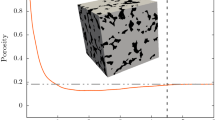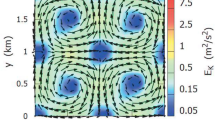Abstract
The investigation of dispersion by microscopic simulations yields a lot of detailed information. To identify characteristic behaviours, it is useful to condense this information into a few effective parameters, which describe the transport process in the model geometry on a larger scale. For this purpose, a very simple two-velocity model has been developed, which models the transition from reversible to irreversible spreading of a tracer volume. It is shown that this model is very similar to Taylor–Aris dispersion and that it is quite suitable to approximate the time dependence of dispersion. The model is applied to characterize the effect of dead end pores on dispersion with a single correlation parameter. Up to Péclet numbers of about 500, 'hold-up'-dispersion similar to Taylor–Aris-dispersion is found. The simulations have been performed by the lattice Bhatnagar–Gross–Krook (BGK) method, which is a particular type of cellular automata and therefore allows an easy implementation of complicated geometries. The fully irreversible asymptotic dispersion is reached in an exponential process, the parameters of which can be identified by the two-velocity model after the mixing has noticeably begun. These are used to extrapolate the process which reduces the computational effort by about one order of magnitude.
Similar content being viewed by others
References
Amaral-Souto, H. P. and Moyne, C.: 1997, Dispersion in two-dimensional periodic porous media. Part 2. Dispersion tensor, Phys. Fluids 9, 2253-2263.
Aris, R.: 1956, On the dispersion of a solute in a fluid flowing through a tube, Proc. R. Soc. Lond. A 235, 67-77.
Baudet, C., Hulin, J. P., Lallemand, P. and d'Humières, D.: 1989, Lattice-gas automata: A model for the simulation of dispersion phenomena, Phys. Fluids A 1, 507-512.
Bhattacharya, R. and Gupta, V. K.: 1990, Application of central limit theorems to solute dispersion in saturated porous media: from kinetic to field scales, In: J. H. Cushman, Dynamics of Fluids in Hierarchical Porous Media, Academic Press, London, pp. 60-96.
Brenner, H.: 1991, Macrotransport Processes, Butterworth-Heinemann, Boston.
Chen, S., Wang, Z., Shan, X., and Doolen, G. D., Lattice Boltzmann computational fluid dynamics in three dimensions, J. Stat. Phys. 68, 379.
Coats, K. H. and Smith, B. D.: 1964, Dead-end pore volume and dispersion in porous media, Soc. Pet. Engng J. 4, 73.
Flekkøy, E. G.: 1993, Lattice Bhatnagar-Gross-Krook models for miscible fluids, Phys. Rev. E 47, 4247-4258.
Gao, Y. and Sharma, M. M.: 1994, A LGA model for dispersion in heterogeneous porous media, Transport in Porous Media 17, 19-32.
Gutfraind, R. and Hansen, A.: 1995, Study of fracture permeability using lattice gas automata, Transport in Porous Media 18, 131-149.
Grubert, D.: 1998, Bestimmung effektiver Dispersivitäten durch Simulationen mit der Gitter-BGK-Methode, Fortschritt-Berichte VDI, Reihe 7, VDI-Verlag GmbH, Düsseldorf. (Dissertation, Department of Geophysics and Meteorology of the Technical University of Braunschweig)
Honerkamp, J.: 1990, Stochastic Dynamic Systems, VCH Verlagsgesellschaft, Weinheim.
Jury, W. A. and Roth, K.: 1990, Transfer Functions and Solute Movement Through Soils, Birkhäuser Verlag, Basel.
Lenormand, R. and Wang, B.: 1995, A stream tube model for miscible flow, Transport in Porous Media 18, 236-282.
Oxaal, U., Flekkøy, E. G. and Feder, J.: 1995, Irreversible dispersion at a stagnation point: Experiments and lattice Boltzmann simulations, Phys. Rev. Lett. 72, 3514-3517.
Pfingsten, W. and Mull, R.: 1990, Transport phenomena in fractured aquifers, Deutsche Gewässerkundliche Mitteilungen 34, 116-123.
Qian, Y. H., d'Humières, D. and Lallemand, P.: 1992, Lattice BGK models for Navier-Stokes equations, Europhys. Lett. 17, 479-484.
Sahimi, M.: 1995, Flow and Transport in Porous and Fractured Rock, VCH Verlagsgesellschaft, Weinheim.
Salles, J., Thovert, J.-F., Delannay, R., Prevors, L., Auriault, J.-L. and Adler, P. M.: 1993, Taylor diespersion in porous media. Determination of the dispersion tensor, Phys. Fluids A 5, 2348-2376.
Scheidegger, A. E.: 1961, General theory of dispersion in porous media, J. Geophys. Res. 66, 3273-3278.
Author information
Authors and Affiliations
Rights and permissions
About this article
Cite this article
Grubert, D. Effective Parameter Interpretation and Extrapolation of Dispersion Simulations by Means of a Simple Two-Velocity Model. Transport in Porous Media 37, 153–167 (1999). https://doi.org/10.1023/A:1006678923565
Issue Date:
DOI: https://doi.org/10.1023/A:1006678923565




